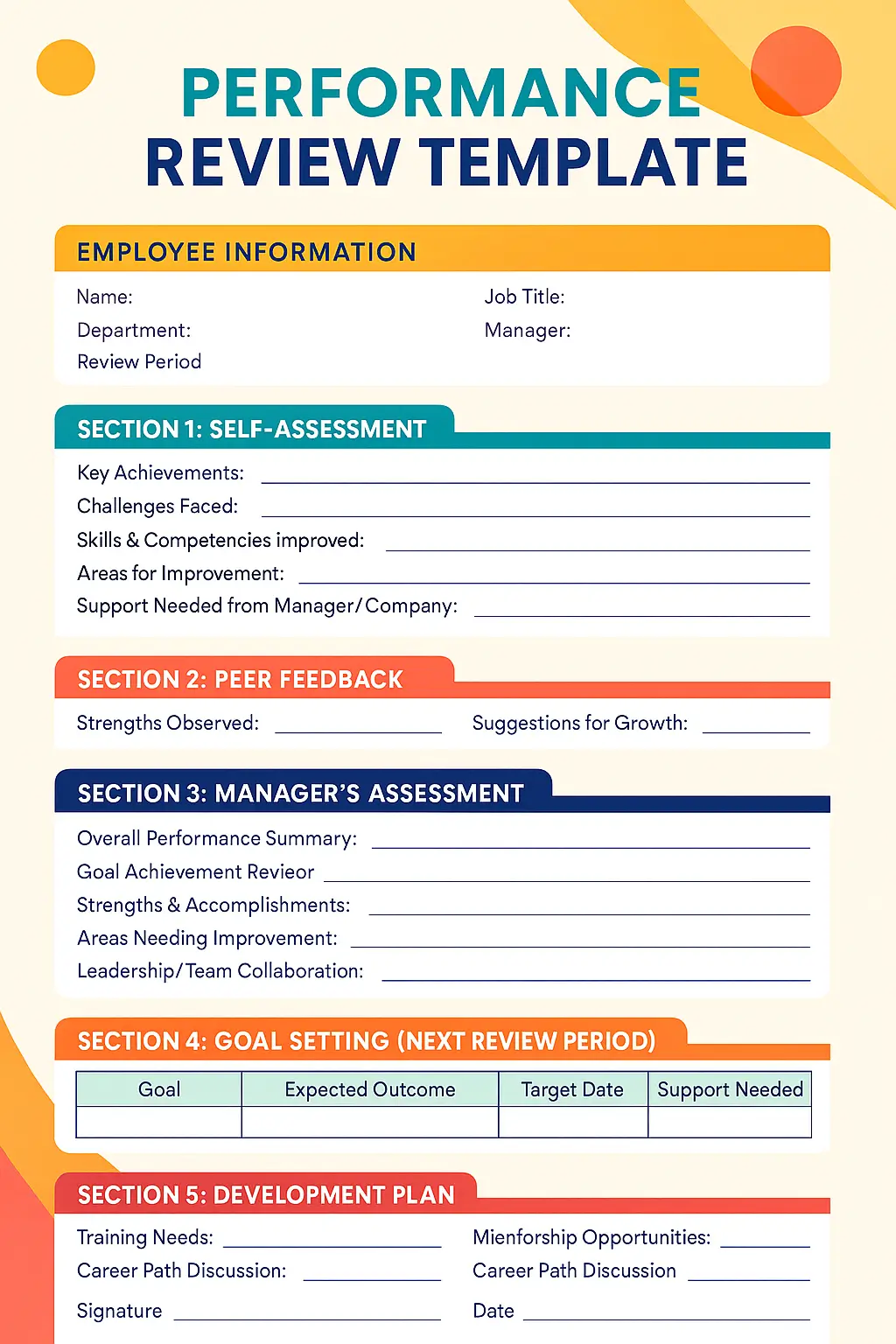The 10 Best Performance Management Software in the UK (2025)

Performance management in 2025 looks very different from the annual review cycles most HR teams used to run a few years ago. Spreadsheets, static forms, and one-off check-ins have had their day – they’re slow, admin-heavy, and don’t give managers the insights they need to help people grow.
Today, companies expect more. The best performance management software doesn’t just run reviews; it makes performance conversations continuous, connects individual goals to company strategy, and gives leaders real-time data to make better decisions.
I’ve researched and compared the top platforms used by HR leaders across the UK. This guide brings together the tools that consistently stand out – whether you’re a fast-growing startup needing simple, automated reviews, or a larger organisation looking for 360° feedback, goal-setting, and engagement surveys all in one place.
What makes the best performance management software in 2025?
Modern HR teams care about more than ticking boxes. They want performance management tools that help them:
- Support employee growth: Clear goals, constructive feedback, and regular conversations that drive development.
- Take care of the admin: HR teams want to spend less time chasing forms, more time spent on coaching and strategy.
- Bring data into the process: Real-time insights into performance trends, engagement levels, and manager effectiveness.
- Build a feedback-first culture: Encourage transparency, recognition, and ongoing feedback.
The best platforms make this easy with features like performance reviews, goal management, engagement surveys, and 360° feedback, all in a simple, user-friendly system.
Performance reviews
Performance reviews are more than just filling out forms once a year. They are critical for evaluating employees and form the basis of any professional development. Effective reviews capture valuable insights that help HR leaders make better business decisions through consistent, high-quality feedback in one place.
Goal management
Performance management software turns goal-setting into more than a quarterly tick-box exercise. Teams can track OKRs or personal development goals in real time, measure progress, and keep priorities visible, so everyone stays aligned.
Surveys
Regular pulse surveys and engagement check-ins give employees a voice and help managers understand what’s working (and what isn’t) before problems escalate. When survey results sit alongside performance data, it’s easier to see the full picture.
The best employee performance management software: A quick review
We’ve pulled together a shortlist of the top platforms used by UK companies today. Whether you need a lightweight tool for quick review cycles or a full HRIS with performance management and payroll, here’s a snapshot of the best options available in the market:
| Platform | Key Features | Best For | Starting Price |
|---|---|---|---|
| Zelt | Automated reviews, 360° feedback, OKR tracking, connected to wider HRIS functionality | Growing UK companies needing all-in-one HR + performance + payroll | From $5/user/month |
| Lattice | Goals & OKRs, performance reviews, feedback, recognition, compensation planning | Scaling companies, goal alignment & strategy | From $11/user/month |
| Leapsome | Reviews, 360 feedback, goals, learning, onboarding, integrations | Fast-growing teams, performance + learning | From $9/user/month |
| Culture Amp | Engagement surveys, performance reviews, 360 cycles, analytics | Mid-to-large firms, engagement-driven strategy | From $10/user/month |
| StaffCircle | Reviews & goals, real-time feedback, learning, succession planning, employee comms | Small to large UK businesses, remote/hybrid teams | From £4.50/user/month |
| PeopleGoal | Reviews, onboarding workflows, OKR tracking, employee surveys | SMBs wanting flexible, customizable workflows | From $10/user/month |
| Clear Review | Continuous feedback, goal tracking, 1-to-1 support, lightweight reviews | SMEs in UK needing simple review cycles | $16/user/month |
| BambooHR | Core HR + database, reviews, goals, time-off, payroll | SMEs needing all-in-one HR + performance | From $10/user/month |
| PerformYard | Custom review cycles, goal tracking, 360 feedback, lightweight reporting | Companies focused only on performance | $5–$10/user/month |
| Workday | HR + payroll + talent, reviews, goals, advanced analytics, finance integration | Large enterprises needing full HR + finance suite | From $20/user/month |
What is Performance Management Software?
Performance management software brings reviews, goals, and feedback into a single system. This saves time and makes it easy to see progress. Both managers and employees can use it to set goals and stay on track with company needs.
This way, performance management is not just manual work. It becomes a strong tool that improves engagement and growth. When people feel engaged, companies see 23% more profit. They also face less turnover and get better productivity.
Most platforms include features like:
- Performance reviews and 360° feedback
- Goal setting and progress tracking
- Engagement surveys and pulse checks
- Employee performance reports and insights
Learn more in our detailed guide: What Is Performance Management Software?
Top 10 employee performance management software in the UK [2025 edition]
Here are 10 of the best performance management software used by companies around the world, especially in the UK. We reviewed each one in detail so you can see their features, pros, and pricing. With this list, you can compare and choose the best tool for your business. It will make tracking and improving performance easier for you and your team.
1. Zelt
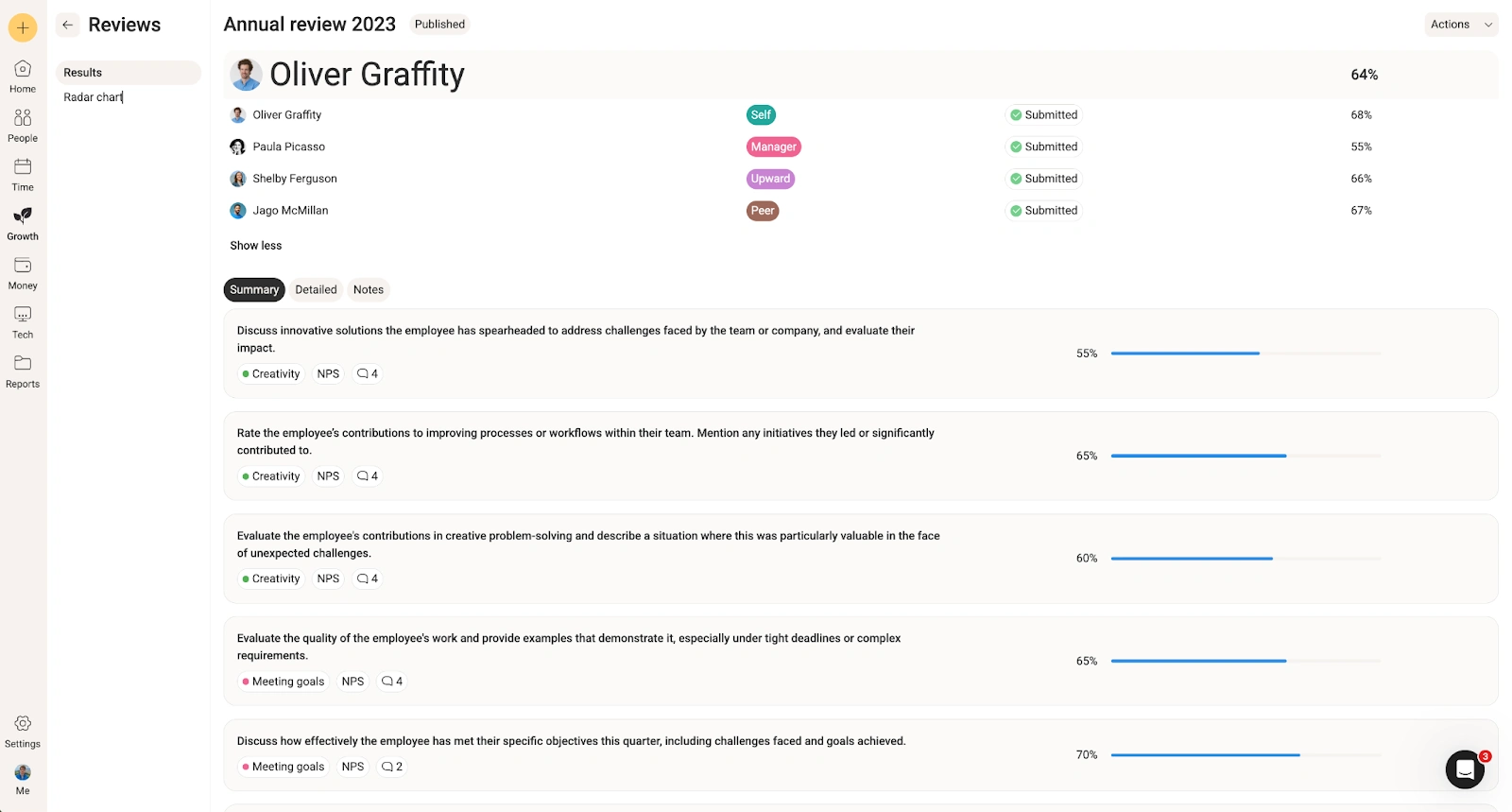
Zelt performance management software is designed for modern teams. It helps managers run smooth review cycles, track goals, and check engagement in one place. The system is fully connected with the rest of your HR and payroll workflows, so reviews fit neatly into the employee lifecycle.
Key features:
- Automated performance reviews: Set timelines, pick questions, add participants, and Zelt runs the rest. From invites to reminders, everything is managed.
- 360° feedback: Collect feedback from managers, peers, reports, and self. Spot strengths, blind spots, and use real insights for growth.
- Smart review templates: Use ready-made performance review questions or design your own. Apply weights, customize scales, and benchmark results.
- Calibration tools: Compare results across teams, reduce bias, and ensure fair outcomes.
Goal tracking & pulse surveys, Link individual and team goals to company objectives and run regular engagement checks to keep feedback continuous.
Zelt’s strengths:
- Unified HR system covering HR, performance, and payroll
- Clean, simple design that’s easy for managers to set up and employees to use
- Automates review cycles and pulse survey check-ins
- Trusted by leading UK companies like Shakespeare’s Globe and fast-growing scaleups like Strapi
Zelt’s limitations:
- Available as part of Zelt’s all-in-one HR system, rather than a standalone tool
Zelt’s pricing depends on company size and selected products as it is a modular platform. Pricing starts at $5/user/month.
G2 Review: “I particularly love the performance growth module as it has made my review process so much easier. I have ratings available, I am no longer chasing for managers or staff to complete, Zelt does this for me” — Claire Castle, HR Director @ Croci Collective
Speak to us to see how Zelt simplifies performance reviews with 360 feedback and AI insights.
2. Lattice
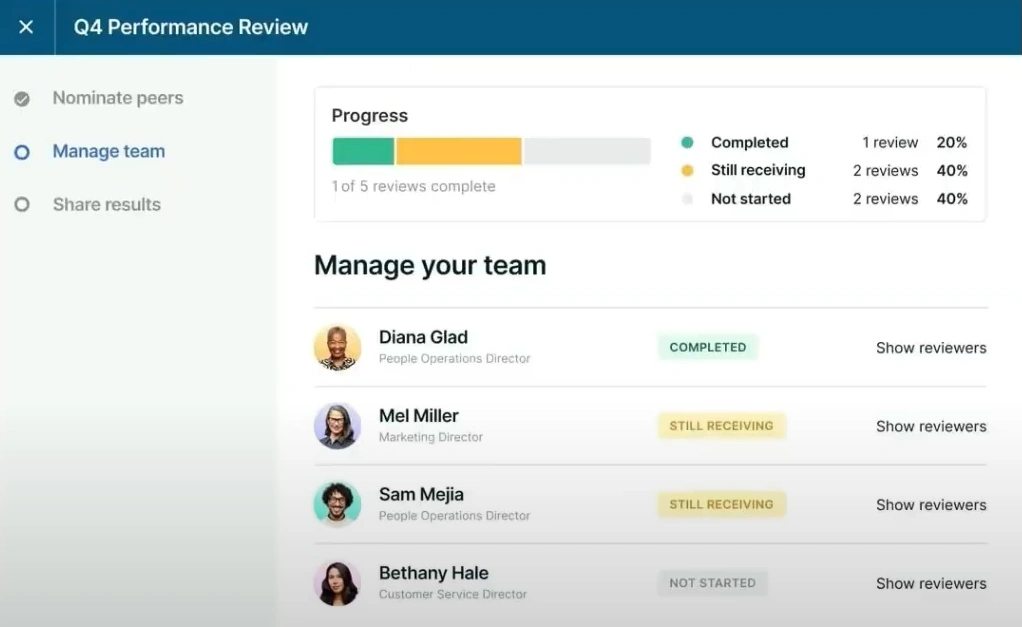
Lattice is a performance management platform used by growing companies. It focuses on goals, OKRs, and pay planning. The tool helps managers align teams with company strategy and supports employee growth with feedback and reviews.
Key Features
- Goal setting and OKRs
- Performance reviews and check-ins
- Feedback and recognition tools
- Compensation and pay planning
Lattice’s strengths:
- Great for strategy and goal alignment
- Wide set of features for HR and managers
- Good integrations with other tools
Lattice’s limitations:
- Can be costly for small teams
- Some users find it hard to set up
- Product focused on performance management only
Pricing
Starts at $11 per user per month. Pricing depends on features chosen.
3. Leapsome
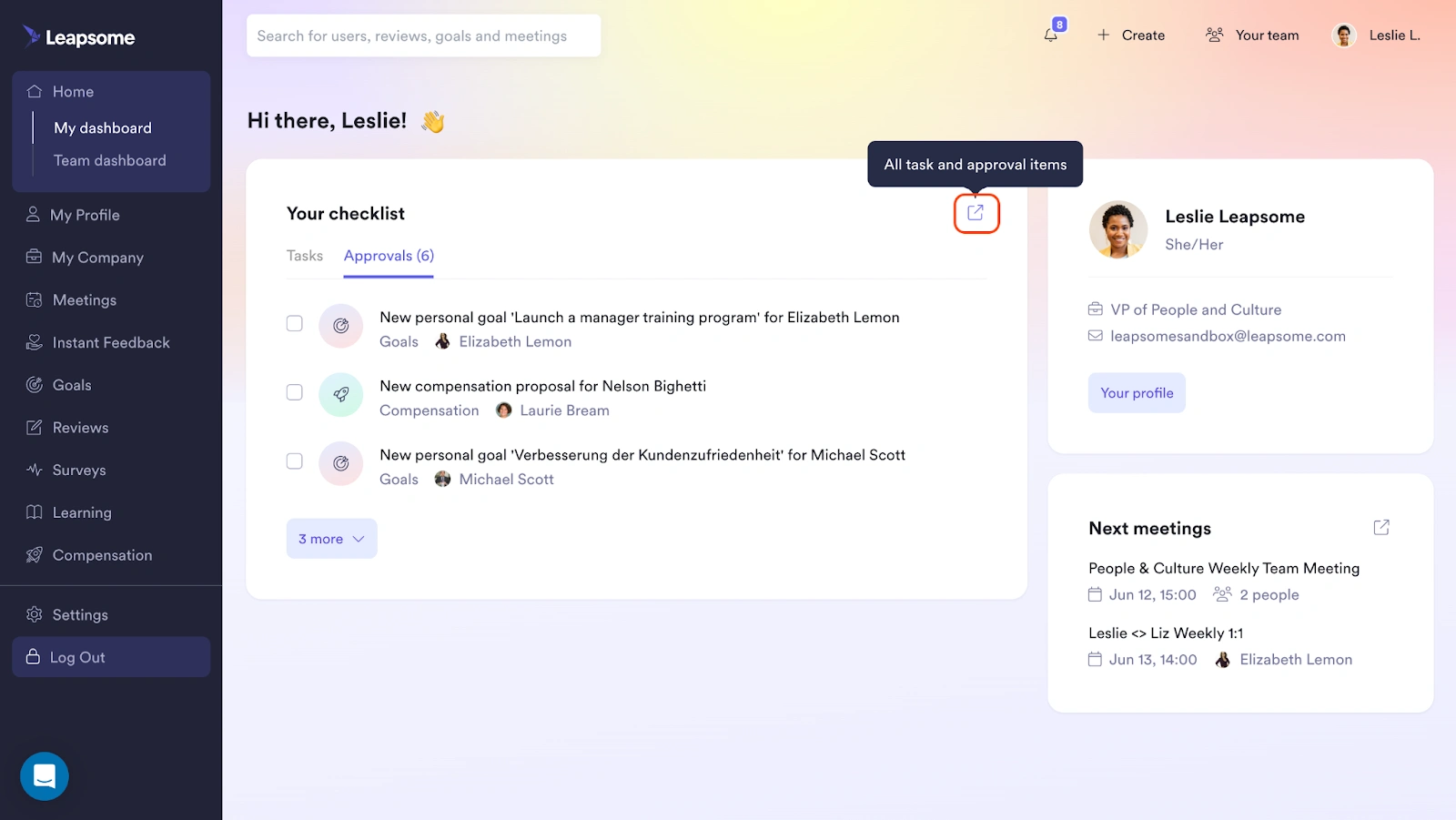
Leapsome is an all-in-one people management platform. It combines reviews, goals, learning, and onboarding in one place. Many fast-growing companies use it to link performance with employee growth and development.
Key Features
- Reviews and 360 feedback
- Goal setting and OKRs
- Learning and training modules
- Onboarding flows
Leapsome’s strengths:
- Covers performance plus learning
- Strong integrations with HR tools
- Flexible setup options
Leapsome’s limitations:
- Interface can feel busy
- Reporting takes time to master
Pricing
Starts at $9 per user per month. Cost depends on modules selected.
4. Culture Amp

Culture Amp is known for engagement surveys but also has strong performance features. It helps HR teams run reviews, track goals, and connect insights with employee engagement data. The tool is designed for mid-sized and large companies.
Key Features
- Performance reviews and goals
- Engagement surveys and feedback
- 360 feedback cycles
- Reports and analytics
Culture Amp’s strengths:
- Combines engagement with performance
- Strong reporting tools
- Good global presence
Culture Amp’s limitations:
- Setup takes time
- Can feel complex for smaller teams
Pricing
Starts at $10/user/month
5. StaffCircle
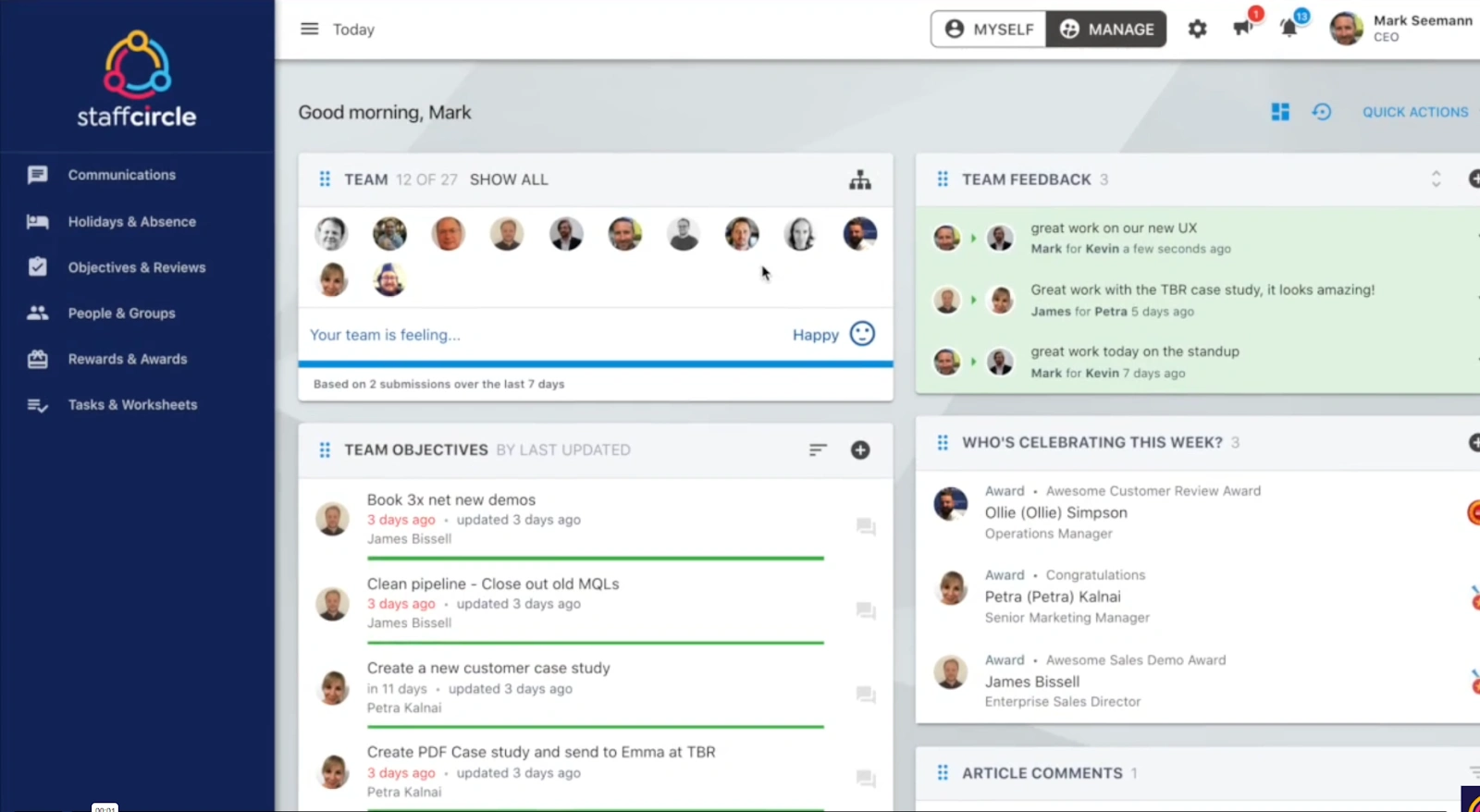
StaffCircle is a UK-based performance management tool. It helps managers and HR teams run reviews, set goals, and track progress. It also combines performance with employee communication. With this, teams can share feedback, surveys, and recognition in one place. It works for both small and large companies, making it flexible for growth.
Key Features
- Performance reviews and goal tracking
- Real-time feedback and recognition
- Learning and development tools
- Succession planning and workflows
StaffCircle’s strengths:
- Easy to use dashboard
- Strong focus on feedback and engagement
- Good for remote and hybrid teams
- Covers more than just performance
StaffCircle’s limitations:
- Takes time to learn all features
- Can feel complex for very small teams
Pricing
Starts at £4.50/user/month
6. PeopleGoal
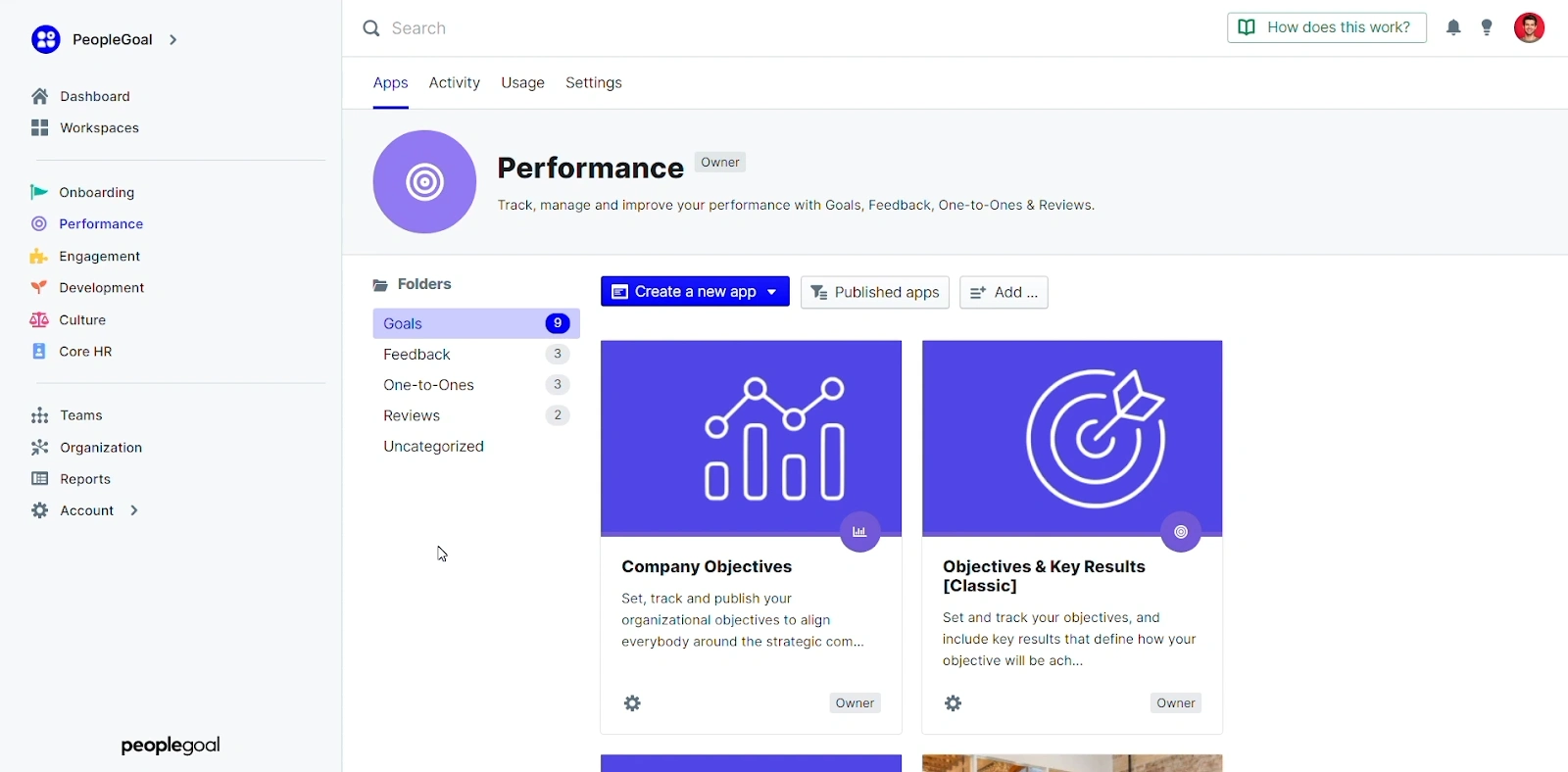
PeopleGoal is a flexible platform for performance and engagement. It allows HR teams to design workflows for reviews, onboarding, and employee development. The tool works well for teams that want simple custom flows without coding.
Key Features
- Performance reviews and appraisals
- Onboarding workflows
- Goal and OKR tracking
- Employee feedback and surveys
PeopleGoal’s strengths:
- Flexible and customizable
- Good for growing businesses
- Links with many HR tools
PeopleGoal’s limitations:
- Limited advanced reporting
- Fewer built-in templates
Pricing
Starts at $10 per user per month. Custom plans available.
7. Clear Review
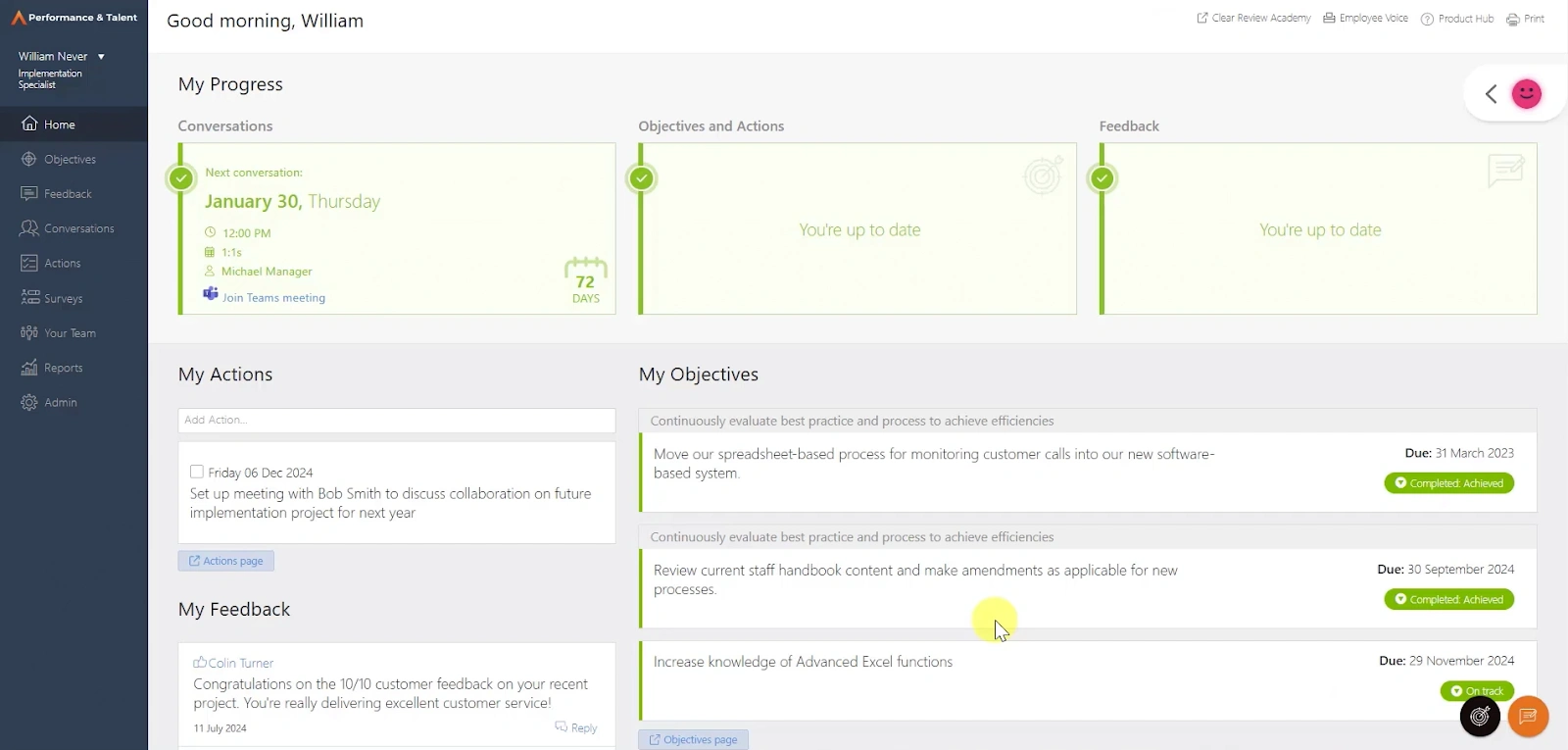
Clear Review is a UK-based tool focused on simple and continuous performance management. It removes the stress of yearly reviews by making feedback and goals ongoing. It is easy to set up and works well for HR teams looking for a clean solution.
Key Features
- Continuous performance reviews
- Goal and objective tracking
- 1-to-1 meetings support
- Employee feedback tools
Clear Review’s strengths:
- Very easy to use
- Focused on ongoing feedback
- Quick to set up for teams
Clear Review’s limitations:
- Limited customization
- Fewer advanced HR features
Pricing
Pricing is custom but mostly starts from $16/user/month. You need to request a quote from Clear Review.
8. BambooHR
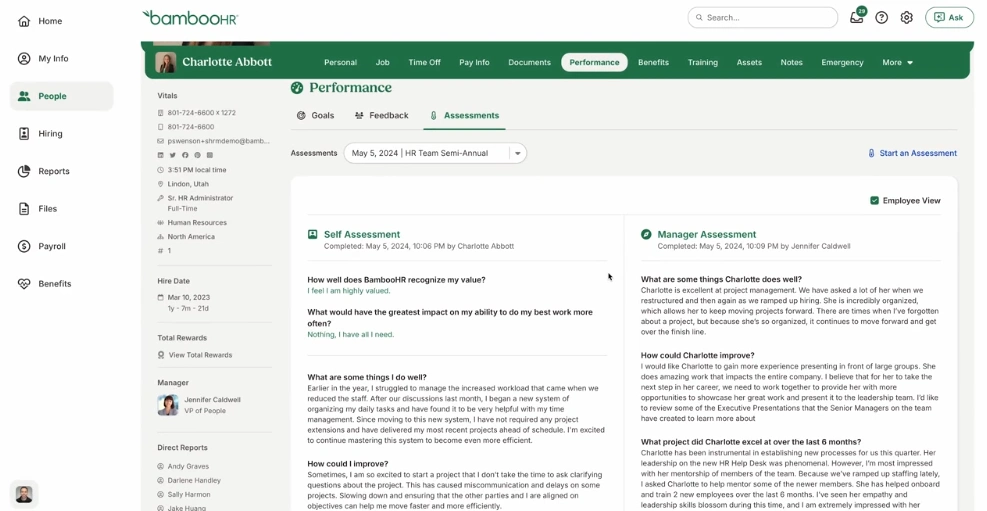
BambooHR is an HR system with performance management built in. It gives small and mid-sized businesses one place for HR, payroll, and performance reviews. The tool is simple and clean, making it easy for teams to get started.
Key Features
- Employee database and HR core
- Performance reviews and goals
- Time-off tracking and payroll
- Reports and analytics
BambooHR’s strengths:
- All-in-one HR plus performance
- Simple and user-friendly design
- Trusted by many SMEs
BambooHR’s limitations:
- Limited advanced performance features
- Not as flexible as standalone tools
Pricing
Pricing is custom. Plans depend on company size and features. But mostly start from $10–$22/user/month
9. PerformYard
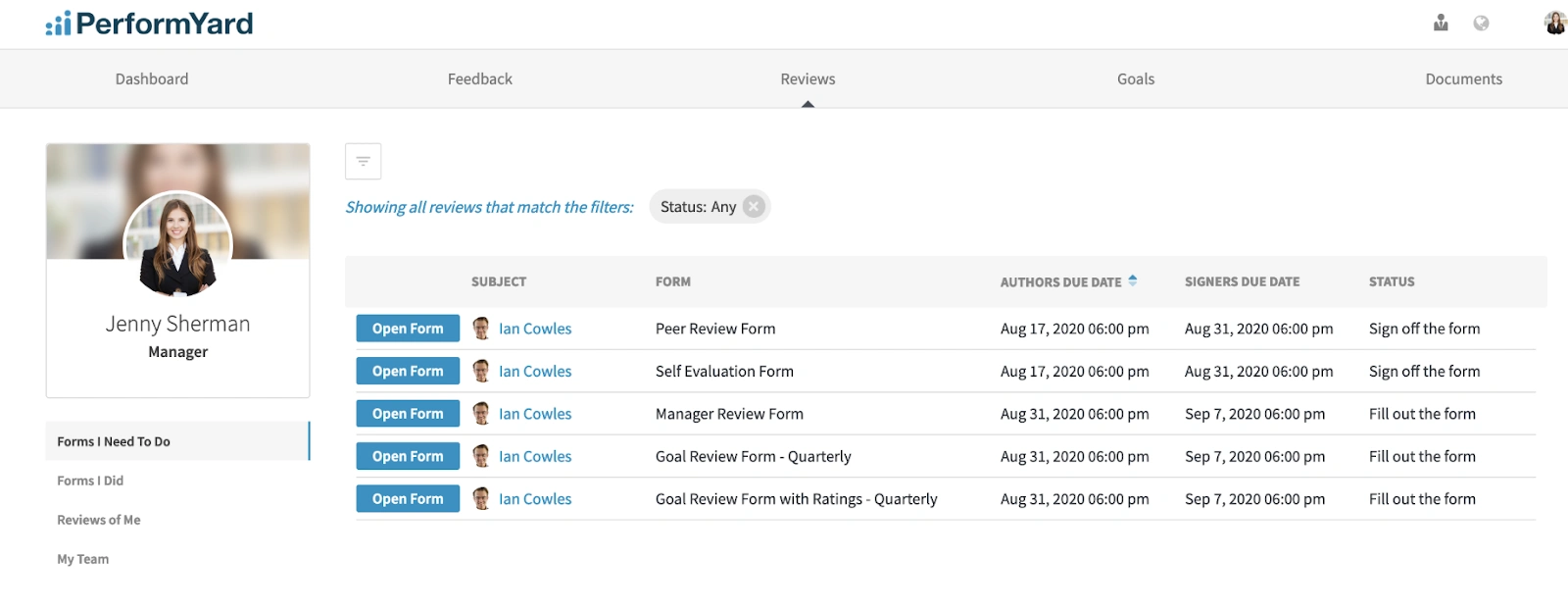
PerformYard is focused only on performance management. It helps HR teams design custom review cycles and feedback processes. The tool is built to give managers and HR flexibility without adding extra features.
Key Features
- Custom performance reviews
- Goal tracking and alignment
- 360 feedback and check-ins
- Reporting tools
PerformYard’s strengths:
- Very flexible setup
- Focus only on performance
- Good support team
PerformYard’s limitations:
- Older style interface
- Lacks extra HR features
Pricing
Starts at $5–$10 per user per month, depending on features.
10. Workday
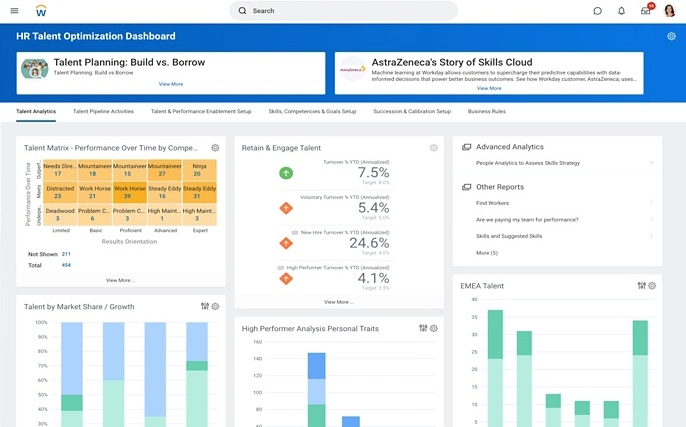
Workday is a global HR and payroll platform with strong performance tools. It is made for large enterprises and brings reviews, goals, and analytics into one system. Many big companies use Workday as a full HR suite.
Key Features
- Performance reviews and goals
- HR, payroll, and talent management
- Advanced analytics and insights
- Integration with finance and planning
Workday’s strengths:
- Very powerful for large firms
- All-in-one HR and finance solution
- Strong analytics and insights
Workday’s limitations:
- Complex to set up
- High cost, best for big enterprises
Pricing
Pricing is custom and usually higher than smaller tools (Approx $20 per user per month).
Benefits of implementing performance management software
There are many benefits of using performance management software. Here are some of the main ones:
Continuous feedback
Performance management tools allow organizations to give continuous feedback easily. In the past, companies only conducted performance reviews annually or half-yearly. But continuous feedback means that managers and employees can have constructive discussions. It provides guidance and solves ongoing communication problems. It also promotes personal development and strengthens a culture of continuous improvement.
Alignment of individual and organizational goals
A performance management tool also helps to align individual goals with overall company objectives. That way, each employee can see how their work fits in the bigger picture. It promotes unified direction and a shared sense of purpose.
Data-driven decisions
Performance management platforms give numbers you can trust. It shows clear trends about employee work and growth. HR teams can use this data for different purposes like hiring, promotions and training. It also helps to decide where to use time and money. With facts, choices are fair and smart. This makes HR a stronger part of the business.
Improved employee engagement and retention
Employees feel more valued with clear goals and regular feedback. This builds trust and motivation. Engaged workers stay longer, and they work better. A company with happy people saves hiring costs and grows faster in the long run.
How to choose the best employee performance management software
Finding the right performance management software isn’t just about features. It’s about choosing a tool that fits your culture, your goals, and the way your managers and employees work every day. Here’s how to approach it:
1. Determine your real challenges and needs
Ask yourself: where are things breaking down today?
- Are reviews inconsistent or always late?
- Do employees feel disconnected from goals?
- Is engagement data scattered across too many tools?
The platform you decide to go with should solve those pain points first. You can use a performance review assessment tool to help you quantify the value from implementing a tool.
2. Balance the cost with the value
Most tools charge per employee, but pricing models vary widely. Some bundle performance with HR and payroll, others focus only on reviews and feedback. Look beyond the headline cost — factor in how much time it will save your HR team and whether it prevents expensive mistakes, like missed compliance reviews or poor retention.
Also make sure you know what is included, and if there are hidden fees. A tool should save you time and money, not add stress.
3. Compare at least 2-3 vendors
Do not stop at the first option. Check reviews, look at demos, and ask for case studies relevant to your industry or challenges. This gives you a clearer idea of how the software will work in practice and whether it is the right fit for your business.
4. Plan for growth and ease of use
Your business will grow, and your tool should grow with you. Pick software that is easy for managers and employees to use, but also strong enough to handle more people, more complexity, and more data later.
In short, think of needs, cost, options, and growth. If a tool ticks all four, it is a smart pick.
Try Zelt, the best performance management software for UK businesses
After reviewing the top platforms in the UK market, Zelt stands out as the best performance management software for companies that want modern, continuous performance management as part of the wider employee lifecycle.
Unlike standalone tools, Zelt is an all-in-one HR system that connects performance management, payroll, and core HR into a single platform. That means no more chasing managers for feedback, manually tracking goals in spreadsheets, or juggling data across multiple systems.
With Zelt, you get:
- Smooth-like butter performance reviews: Automated cycle invites and reminders, 360° feedback, and smart templates.
- Clear goal tracking: Collect feedback from peers, managers, and reports while linking individual goals to company-wide objectives.
- Pulse-surveys: Hear employees, track engagement, and act on real insights.
- One connected HR system: Zelt unifies all people operations – from performance management, to onboarding, to payroll, so HR teams always have the full picture.
If you want performance management that saves time, builds trust, and grows with your team, Zelt is the tool to try.
Frequently Asked Questions
How does performance management software improve team productivity?
Performance management tools keep employees aligned, motivated, and clear on expectations. With tools like Zelt, managers can run reviews, set goals, and track progress in one place — so performance conversations actually happen on time, and action plans don’t get lost in the shuffle.
Is performance management software suitable for small businesses?
Absolutely. Performance management software can work well for small businesses. In fact, it can be a great option for them. It helps make HR processes simple and smooth. Small businesses often have limited resources, and this tool helps them use those resources in the best way.
What are the 3 types of performance management systems?
The following are the 3 types of performance management systems:
- Traditional performance management systems: This typically involves annual or biannual reviews.
- Continuous performance management systems: This type involves regular check-ins, real-time feedback, and ongoing goal-setting.
- 360-degree feedback systems: In this type feedback is collected from multiple sources, including peers, subordinates, and supervisors.
What are the 4 pillars of performance management?
The four main pillars are:
- Planning: setting clear goals and expectations.
- Monitoring: tracking progress and giving feedback.
- Developing: supporting employee growth through training and coaching.
- Rewarding: recognizing and rewarding good performance.
What should I look for in performance management software in 2025?
Look for tools that go beyond annual reviews. Features like automated review cycles, goal tracking, and integration with HR workflows are now essential. AI-powered insights and engagement analytics are also becoming standard.

